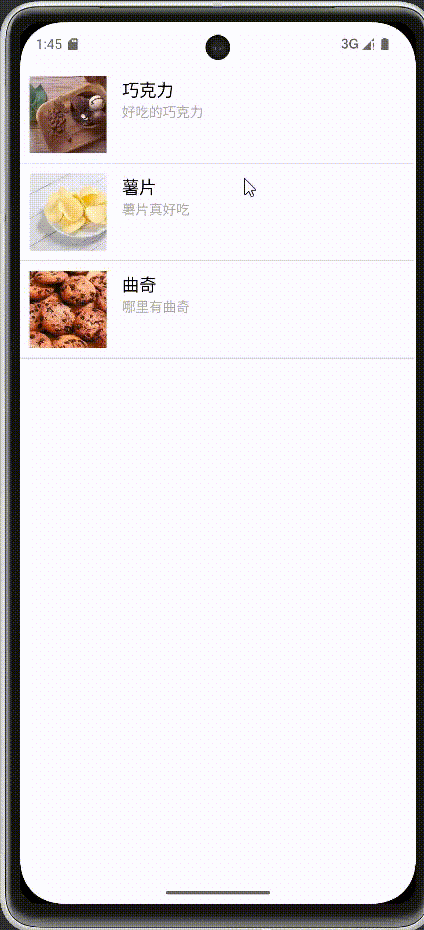本代码使用的Android版本:android-studio-2024.2.1.11-windows
目录
本文章还有使用自定义适配器来实现该功能的那一篇博客,自定义适配器那一片文章博客链接如下:
本篇文章先介绍基础适配器的基础使用方法
实现效果图
废话先不多说,先看效果图

一、适配器的五个主要参数
下面这部分的代码块是创建SimpleAdapter的五个参数。
//装配适配器
SimpleAdapter adapter = new SimpleAdapter(
this, // 上下文
productData, // 数据源
R.layout.item_commodity, // 自定义布局资源 item
new String[]{"name", "description", "image"}, // 数据源中的键数组
new int[]{R.id.productName, R.id.productDescription, R.id.productImage} // 布局文件中的视图 ID 数组
);上下文环境:在OnCreate中的this就是上下文环境,可以直接输入
数据源:根据键数组填充的数据源。列如:[巧克力,巧克力是由可可制作而成,图片(巧克力的图片)]又或者是[薯片,薯片是由土豆制作而成,图片(巧克力的图片)]
自定义布局:在res/layout布局下自定义一个布局item,用于装载。后续在ListView中每一个List都是这个自定义布局,类似一种模板
数据源中的键数组:所需要的参数的变量名,列如商品中有名字、描述、图片,这三个,所以在键数组中填入"name","description","image"。
布局中的控件:在自定义布局中键数组对应的控件
二、功能实现的代码(模板):
下述是本功能实现的代码
1.Store主页面:
页面代码:
<?xml version="1.0" encoding="utf-8"?>
<androidx.constraintlayout.widget.ConstraintLayout xmlns:android="http://schemas.android.com/apk/res/android"
xmlns:app="http://schemas.android.com/apk/res-auto"
xmlns:tools="http://schemas.android.com/tools"
android:id="@+id/main"
android:layout_width="match_parent"
android:layout_height="match_parent"
android:fitsSystemWindows="true"
tools:context=".Store">
<ListView
android:id="@+id/listView"
android:layout_width="409dp"
android:layout_height="729dp"
tools:layout_editor_absoluteX="1dp"
tools:layout_editor_absoluteY="1dp"
tools:ignore="MissingConstraints" />
</androidx.constraintlayout.widget.ConstraintLayout>Java代码:
package com.example.test03;
import android.os.Bundle;
import android.widget.ListView;
import android.widget.SimpleAdapter;
import androidx.activity.EdgeToEdge;
import androidx.appcompat.app.AppCompatActivity;
import java.util.ArrayList;
import java.util.HashMap;
import java.util.List;
import java.util.Map;
public class Store extends AppCompatActivity {
@Override
protected void onCreate(Bundle savedInstanceState) {
super.onCreate(savedInstanceState);
EdgeToEdge.enable(this);
setContentView(R.layout.activity_store);
//获取数据
List<Map<String, Object>> productData = GetDate();
//装配适配器
SimpleAdapter adapter = new SimpleAdapter(
this, // 上下文
productData, // 数据源
R.layout.item_commodity, // 自定义布局资源 item
new String[]{"name", "description", "image"}, // 数据源中的键数组
new int[]{R.id.productName, R.id.productDescription, R.id.productImage} // 布局文件中的视图 ID 数组
);
ListView listView = findViewById(R.id.listView);
listView.setAdapter(adapter);
//如果想要得到效果图中的功能的话,需要为他设置一个监听器,如下
listView.setOnItemClickListener(new AdapterView.OnItemClickListener() {
@Override
public void onItemClick(AdapterView<?> parent, View view, int position, long id) {
// 获取被点击项目的数据
Map<String, Object> clickedItem = (Map<String, Object>) parent.getItemAtPosition(position);
String productName = (String) clickedItem.get("name");
String productDescription = (String) clickedItem.get("description");
// 在这里处理点击事件,比如显示一个 Toast 消息
Toast.makeText(Store.this, "你点击了 " + productName + "\n" + productDescription, Toast.LENGTH_LONG).show();
}
});
}
//用于获取数据
private List<Map<String, Object>> GetDate() {
List<Map<String, Object>> productData = new ArrayList<>();
//根据数据源中的键数组来填充数据
//new String[]{"name", "description", "image"},
// 创建巧克力商品数据
Map<String, Object> chocolate = new HashMap<>();
chocolate.put("name", "巧克力");
chocolate.put("description", "好吃的巧克力");
chocolate.put("image", R.drawable.chocolate);
productData.add(chocolate);
// 创建薯片商品数据
Map<String, Object> chips = new HashMap<>();
chips.put("name", "薯片");
chips.put("description", "薯片真好吃");
chips.put("image", R.drawable.chips);
productData.add(chips);
// 创建饼干商品数据
Map<String, Object> cookies = new HashMap<>();
cookies.put("name", "曲奇");
cookies.put("description", "哪里有曲奇");
cookies.put("image", R.drawable.cookies);
productData.add(cookies);
// 可以继续添加更多商品数据...
return productData;
}
}2.item_commodity模板界面:
<?xml version="1.0" encoding="utf-8"?>
<LinearLayout xmlns:android="http://schemas.android.com/apk/res/android"
android:layout_width="match_parent"
android:layout_height="wrap_content"
android:orientation="horizontal"
android:padding="10dp">
<ImageView
android:id="@+id/productImage"
android:layout_width="80dp"
android:layout_height="80dp"
android:src="@drawable/ic_launcher_foreground" />
<LinearLayout
android:layout_width="0dp"
android:layout_height="wrap_content"
android:layout_weight="1"
android:orientation="vertical"
android:paddingStart="16dp"
android:paddingEnd="16dp"
android:gravity="center_vertical">
<TextView
android:id="@+id/productName"
android:layout_width="wrap_content"
android:layout_height="wrap_content"
android:text="商品名"
android:textSize="18sp"
android:textColor="@android:color/black" />
<TextView
android:id="@+id/productDescription"
android:layout_width="wrap_content"
android:layout_height="wrap_content"
android:text="描述"
android:textSize="14sp"
android:textColor="@android:color/darker_gray" />
</LinearLayout>
</LinearLayout>三、结语
本账号共为介绍适配器写了4篇文章(包括本文在内),相信你看完这几篇文章,你基本学会了适配器90%的使用了。其余三篇文章链接如下:
Android中使用自定义适配器完成对ListView的使用方法,附带可修改模板![]() https://blog.youkuaiyun.com/rawmeat/article/details/144251368?spm=1001.2014.3001.5501Android中在自定义适配器中使用多个item展示在ListView中,附带代码实现、框架模板
https://blog.youkuaiyun.com/rawmeat/article/details/144251368?spm=1001.2014.3001.5501Android中在自定义适配器中使用多个item展示在ListView中,附带代码实现、框架模板![]() https://blog.youkuaiyun.com/rawmeat/article/details/144284315?spm=1001.2014.3001.5501
https://blog.youkuaiyun.com/rawmeat/article/details/144284315?spm=1001.2014.3001.5501
本篇文章的分享就到这里了,制作不易,觉得实用的就点个收藏吧!






















 905
905

 被折叠的 条评论
为什么被折叠?
被折叠的 条评论
为什么被折叠?








